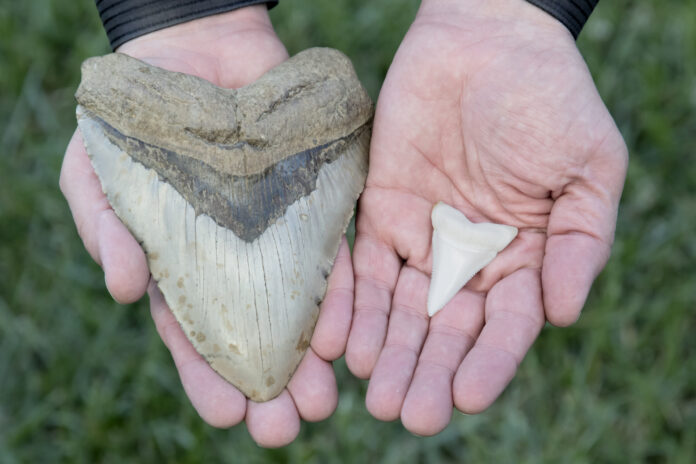The great white shark is a formidable oceanic hunter. Its powerful jaws are capable of exerting over 4,000 pounds per square inch (PSI) of bite force — enough to shatter a human femur.
But compared to the megalodon, a giant prehistoric shark that roamed the oceans from 15 million to 3.6 million years ago, the great white seems like a mere minnow. The megalodon had a sleek body estimated to exceed 60 feet in length, according to a 2024 paper published in Palaeontologia Electronica, dwarfing its modern counterpart. (The biggest great white sharks only reach up to 20 feet long.)
While adult great whites primarily feast on smaller marine mammals, like seals and sea lions, the megalodon targeted larger prey, particularly whales. With this evidence of bite marks on ancient marine mammal bones, it begs the question, how strong did the megalodon bite have to be?
Read More: Larger, 65-foot-long Megalodon Might Have Fed on Whales
How Powerful Was a Megalodon’s Bite?
Calculations based on fossilized megalodon teeth estimate its bite force at a staggering 40,000 PSI, 10 times more powerful than that of a great white, making it the undisputed champion of biting prowess — surpassing even the Tyrannosaurus rex, which scientists estimate used between 8,000 pounds and 13,000 pounds of force to shred apart its meals.
But what fueled the megalodon’s insatiable appetite for carnage? Scientists believe it patrolled coastlines and shallow seas during the Pleistocene, feasting on whales and large fish, as well as other sharks. Its colossal jaws — measuring 9 feet by 11 feet — could devour almost anything in its path, from sea cows to seals.
Despite its unmatched ferocity, the megalodon was driven to extinction due to climate change and subsequent shifts in whale migration patterns, depriving it of its primary food source.
Read More: What Is a Megalodon? Facts About One of the Biggest Sharks in History
Were There Other Prehistoric Predators Like Megalodon?
Of course, the megalodon was not the only formidable — and sizable — creature to roam the ancient seas. Mosasaurs, for instance, were another group of apex predators that dominated the oceans during the Cretaceous, from 130 million to 65 million years ago, well before the age of the megalodon.
These massive marine reptiles, a type of aquatic lizard, evolved into a diverse array of species, with some reaching lengths of up to 60 feet. They hunted a variety of prey, including fish, turtles, and even other mosasaurs.
One of the most well-known of these creatures is Mosasaurus hoffmannii, which is estimated to have had a bite force ranging from 13,000 PSI to 16,000 PSI. With its streamlined body and powerful jaws, these reptiles could be potent predators.
Beyond that, mosasaurs also boast a fascinating evolutionary history. These creatures are believed to have evolved from a group of land-dwelling reptiles known as varanids, which includes modern-day monitor lizards. Over time, they adapted to life in the water, developing features such as flippers and a tail fluke for propulsion.
Read More: Originally Having a Stocky Build, the Gigantic Megalodon Gets a New Physique
What Else Lived During Megalodon’s Time?
While mosasaurs were undoubtedly fearsome predators, they predated the megalodon by some 50 million years. But Livyatan melvillei, a prehistoric sperm whale, was among the other titanic aquatic animals that lived alongside the megalodon. Named after Herman Melville’s famous novel Moby Dick, these marine mammals were equipped with massive teeth, some of which measured nearly a foot in length.
Like the megalodon, Livyatan is believed to have preyed on large marine mammals, including other whales. However, while megalodons likely hunted alone, Livyatan may have been a social animal, exhibiting similar dynamics to modern day cetaceans like whales and dolphins.
While the exact bite force of the ancient whale remains speculative, its formidable mandible suggests a potent force, although likely overshadowed by the megalodon. The hypothetical clash between these ancient leviathans remains a subject of fascination, with the megalodon’s raw power potentially overwhelming Livyatan’s mammalian intelligence.
Scientists have theorized that the Livyatan went extinct for the same reason as the megalodon: large-scale climate change likely disrupted its food supply, according to a 2010 paper in Nature.
Despite their extinction millions of years ago, the legacy of these ancient predators lives on in the fossil record today.
Read More: The Massive Megalodon Shark Was No Cold-Blood Killer
Source : Discovermagazine






